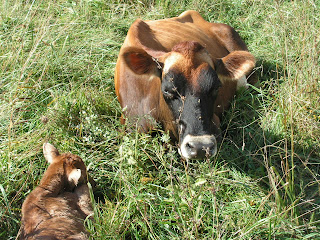Happy October!
The autumn air brings more than clear skies and blowing leaves. Besides the sense of imminent cold and cleaning to the soil, earth and air, it brings in crops, and new cows to the farm!
It's easy to be content watching cloud formations and feeling cozy in a morning sweater, waiting for the heat of noon, but when there's work to do, it doesn't wait! Diggin potatoes, storing them--nearly 400 pounds from the upper garden--, clipping ears of flour corn before the 'coons get them first, hanging each one to dry, canning beans and curing pumpkins in the sun. Sweet potatoes, red and white have to be dug, and the oats, peas and wheat planted (and protected from the chicken flock!)
Most that was done last week and thankfully so, because this week delivered two blessings from the grassy-hill-fed wombs of Dana and Willa: a calf each, both girls, two Jersey cows, suckling, bleating and romping free (for at least a few days before weaning from their mothers).

Kevin bottle-feeds Dana's calf for the first time. She was born October 4 and lives in a spacious pen protected from the weather with a house all her own. She'll soon have 3 playmates, another calf born at the farm October 6, and two male goats from Spinning Spider creamery.
Here's Willa, she freshened 3 days ago with a beautiful Heifer calf, a little bigger than Dana's

Traditionally amongst the Native Americans corn was raised for flour or popcorn. Sweet corn is a modern twist on the ancient Maize plant, essentially the immature, sweet ear of grain before it dries down as a stable, starchy cob of kernels . The Appalachian homesteaders likewise raised what they called "indian corn' which was also used for flour, popcorn, and often feed for chickens and pigs. At Raven Ridge Farm, we've raised an open-pollinated variety called Bloody Butcher, for it's crimson red kernels. Open-pollinated means that it's non-hybrid and heirloom, preserved for it's characteristics as a good flour corn, color, and growth through isolation from cross-poliinating and seed saving. We figure that our two bushels of corn will be good for 80 meals of cornbread. This is our corn hanging in the barn:

Here's Dana with her calf the same day she was born. Incredible that a 50 pound baby animal stands up, dries off and begins feeding on milk in no time

Building news: the materials for a timber frame structure are on the ground and ready to set up. Timber framing is the ancient building art of durable, long-lasting construction using large timbers and precise joinery without the nails, expensive products and pre-fabricated modern shortcuts that produce houses of questionable integrity and longevity. Many, if not most, modern houses are built for the purpose of being lived in, sold, lived in again, sold, destroyed and re-built to make profits for realtors and speculators. It's possible the timber-framed house I grew up in, in Massachusetts (circa 1809, 200 years old) will outlive many of these modern day buildings.

See those massive timbers? Posts 6x6 inches and beams to match them. Typical stud construction of houses with 2x4's is quick and saves on labor, but cannot match the sturdy and efficient use of large timbers that will last long if protected from the elements. More later
Geoffrey


